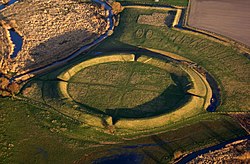| UNESCO World Heritage Site | |
|---|---|
 Aerial view of the Viking ring fortress of Trelleborg, near Slagelse in Denmark. This was the first discovered Viking ring fortress, and the geometry is clearly visible. | |
| Includes | Aggersborg, Fyrkat, Nonnebakken, Trelleborg, and Borgring |
| Criteria | Cultural: iii, iv |
| Reference | 1660 |
| Inscription | 2023 (45th Session) |
| Area | 51 ha |
| Buffer zone | 16,820.8 ha |
A Viking ring fortress, Trelleborg-type fortress, or trelleborg (pl. trelleborgs), is a type of circular fort of a special design, built in Scandinavia during the Viking Age. These fortresses have a strictly circular shape, with roads and gates pointing in the four cardinal directions. Inside the fort, each quadrant has one, in a single case four, square blocks of longhouses, completing the geometric symmetry. There are a total of five confirmed Viking ring fortresses at present, located in Denmark (although sites in Sweden and across Northern Europe have similar construction).[1] They have been dated to the reign of Harold Bluetooth of Denmark, with an estimated near contemporary time of construction c. 980. Their exact historical context is subject to debate. In 2023, the five Danish forts were inscribed on the UNESCO World Heritage List because of their unique architecture and testimony to the military power of the Jelling Dynasty.[2]
- ^ cf. Slots- og Kulturstyrelsen - Nomination of Viking-Age Ring Fortresses, p. 225 ; Runge 2018, p. 49
- ^ Viking-Age Ring Fortresses, UNESCO World Heritage Centre, retrieved 24 January 2024 – via whc.unesco.org